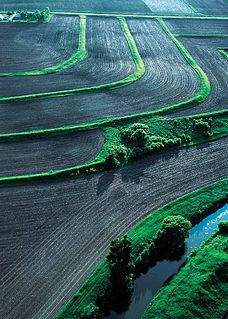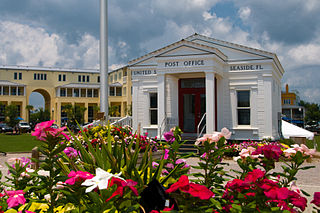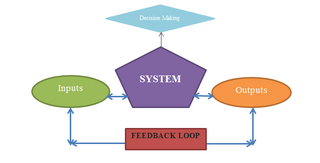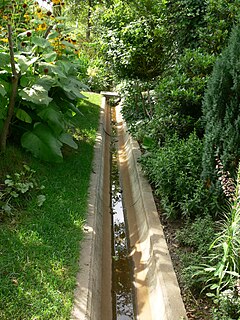 W
WBioregionalism is a philosophy that suggests that political, cultural, and economic systems are more sustainable and just if they are organized around naturally defined areas called bioregions, similar to ecoregions. Bioregions are defined through physical and environmental features, including watershed boundaries and soil and terrain characteristics. Bioregionalism stresses that the determination of a bioregion is also a cultural phenomenon, and emphasizes local populations, knowledge, and solutions.
 W
WBioretention is the process in which contaminants and sedimentation are removed from stormwater runoff. Stormwater is collected into the treatment area which consists of a grass buffer strip, sand bed, ponding area, organic layer or mulch layer, planting soil, and plants. Runoff passes first over or through a sand bed, which slows the runoff's velocity, distributes it evenly along the length of the ponding area, which consists of a surface organic layer and/or groundcover and the underlying planting soil. The ponding area is graded, its center depressed. Water is ponded to a depth of 15 cm (5.9 in) and gradually infiltrates the bioretention area or is evapotranspired. The bioretention area is graded to divert excess runoff away from itself. Stored water in the bioretention area planting soil exfiltrates over a period of days into the underlying soils.
 W
WA constructed wetland (CW) is an artificial wetland to treat municipal or industrial wastewater, greywater or stormwater runoff. It may also be designed for land reclamation after mining, or as a mitigation step for natural areas lost to land development. Constructed wetlands are engineered systems that use natural functions vegetation, soil, and organisms to treat wastewater. Depending on the type of wastewater the design of the constructed wetland has to be adjusted accordingly. Constructed wetlands have been used to treat both centralized and on-site wastewater. Primary treatment is recommended when there is a large amount of suspended solids or soluble organic matter.
 W
WCradle-to-cradle design is a biomimetic approach to the design of products and systems that models human industry on nature's processes, where materials are viewed as nutrients circulating in healthy, safe metabolisms. The term itself is a play on the popular corporate phrase "cradle to grave", implying that the C2C model is sustainable and considerate of life and future generations—from the birth, or "cradle", of one generation to the next generation, versus from birth to death, or "grave", within the same generation.
 W
WEnvironmental assessment (EA) is the assessment of the environmental consequences of a plan, policy, program, or actual projects prior to the decision to move forward with the proposed action. In this context, the term "environmental impact assessment" (EIA) is usually used when applied to actual projects by individuals or companies and the term "strategic environmental assessment" (SEA) applies to policies, plans and programmes most often proposed by organs of state. It is a tool of environmental management forming a part of project approval and decision-making. Environmental assessments may be governed by rules of administrative procedure regarding public participation and documentation of decision making, and may be subject to judicial review.
 W
WThe U.S. Environmental Protection Agency’s (EPA's) Safer Choice label, previously known as the Design for the Environment (DfE) label, helps consumers and commercial buyers identify and select products with safer chemical ingredients, without sacrificing quality or performance. When a product has the Safer Choice label, it means that every intentionally-added ingredient in the product has been evaluated by EPA scientists. Only the safest possible functional ingredients are allowed in products with the Safer Choice label.
 W
WErosion control is the practice of preventing or controlling wind or water erosion in agriculture, land development, coastal areas, river banks and construction. Effective erosion controls handle surface runoff and are important techniques in preventing water pollution, soil loss, wildlife habitat loss and human property loss.
 W
WA grassed waterway is a 2-metre (6.6 ft) to 48-metre-wide native grassland strip of green belt. It is generally installed in the thalweg, the deepest continuous line along a valley or watercourse, of a cultivated dry valley in order to control erosion. A study carried out on a grassed waterway during 8 years in Bavaria showed that it can lead to several other types of positive impacts, e.g. on biodiversity.
 W
WGreen building refers to both a structure and the application of processes that are environmentally responsible and resource-efficient throughout a building's life-cycle: from planning to design, construction, operation, maintenance, renovation, and demolition. This requires close cooperation of the contractor, the architects, the engineers, and the client at all project stages. The Green Building practice expands and complements the classical building design concerns of economy, utility, durability, and comfort. In doing so, the three dimensions of sustainability, i.e., planet, people and profit across the entire supply chain need to be considered.
 W
WGroundwater recharge or deep drainage or deep percolation is a hydrologic process, where water moves downward from surface water to groundwater. Recharge is the primary method through which water enters an aquifer. This process usually occurs in the vadose zone below plant roots and, is often expressed as a flux to the water table surface. Groundwater recharge also encompasses water moving away from the water table farther into the saturated zone. Recharge occurs both naturally and through anthropogenic processes, where rainwater and or reclaimed water is routed to the subsurface.
 W
WHügelkultur is a horticultural technique where a mound constructed from decaying wood debris and other compostable biomass plant materials is later planted as a raised bed. Adopted by permaculture advocates, it is suggested the technique helps to improve soil fertility, water retention, and soil warming, thus benefiting plants grown on or near such mounds.
 W
WLand Art Generator Initiative (LAGI), founded by Elizabeth Monoian and Robert Ferry, is an organization dedicated to devising alternative energy solutions through sustainable design and public art by providing platforms for scientists and engineers to collaborate with artists, architects and other creatives on public art projects that generate sustainable energy infrastructures.Since 2010, LAGI has hosted biannual international competitions stimulating artists to design public art that produces renewable energy. Sites for these contests have included Abu Dhabi, United Arab Emirates, Copenhagen, Denmark, New York City and Santa Monica, California. Land Art Generator Initiative also led efforts that have resulted in the world's first Solar Mural artworks.
 W
WLandscape-scale conservation is a holistic approach to landscape management, aiming to reconcile the competing objectives of nature conservation and economic activities across a given landscape. Landscape-scale conservation may sometimes be attempted because of climate change. It can be seen as an alternative to site based conservation.
 W
WNew Urbanism is an urban design movement which promotes environmentally friendly habits by creating walkable neighborhoods containing a wide range of housing and job types. It arose in the United States in the early 1980s, and has gradually influenced many aspects of real estate development, urban planning, and municipal land-use strategies. New urbanism attempts to address the ills associated with urban sprawl and post-Second World War suburban development.
 W
WPepe may refer to secondhand clothes that are commonly worn by its population in Haiti. These clothes are usually sent from the United States. The Haitian textile industry has suffered due to the widespread popularity of pepe. There have even been discussions about banning the import of pepe. However, this is unlikely since the general population continues to wear pepe, which include many brand names that otherwise would be inaccessible.
 W
WPermaculture is an approach to land management and philosophy that adopts arrangements observed in flourishing natural ecosystems. It includes a set of design principles derived using whole systems thinking. It uses these principles in fields such as regenerative agriculture, rewilding, and community resilience. Permaculture originally came from "permanent agriculture", but was later adjusted to mean "permanent culture", incorporating social aspects as inspired by Masanobu Fukuoka's natural farming. The term was coined by Bill Mollison and David Holmgren in 1978, who formulated the concept in opposition to Western industrialized methods and in congruence with Indigenous or traditional knowledge.
 W
WRain gardens, also called bioretention facilities, are one of a variety of practices designed to treat polluted stormwater runoff. Rain gardens are designed landscape sites that reduce the flow rate, total quantity, and pollutant load of runoff from impervious urban areas like roofs, driveways, walkways, parking lots, and compacted lawn areas. Rain gardens rely on plants and natural or engineered soil medium to retain stormwater and increase the lag time of infiltration, while remediating and filtering pollutants carried by urban runoff. Rain gardens provide a method to reuse and optimize any rain that falls, reducing or avoiding the need for additional irrigation. A benefit of planting rain gardens is the consequential decrease in ambient air and water temperature, a mitigation that is especially effective in urban areas containing an abundance of impervious surfaces that absorb heat in a phenomenon known as the heat-island effect.
 W
WReconciliation ecology is the branch of ecology which studies ways to encourage biodiversity in human-dominated ecosystems. Michael Rosenzweig first articulated the concept in his book Win-Win Ecology, based on the theory that there is not enough area for all of earth’s biodiversity to be saved within designated nature preserves. Therefore, humans should increase biodiversity in human-dominated landscapes. By managing for biodiversity in ways that do not decrease human utility of the system, it is a "win-win" situation for both human use and native biodiversity. The science is based in the ecological foundation of human land-use trends and species-area relationships. It has many benefits beyond protection of biodiversity, and there are numerous examples of it around the globe. Aspects of reconciliation ecology can already be found in management legislation, but there are challenges in both public acceptance and ecological success of reconciliation attempts.
 W
WRegenerative design is a process-oriented whole systems approach to design. The term "regenerative" describes processes that restore, renew or revitalize their own sources of energy and materials. Regenerative design uses whole systems thinking to create resilient and equitable systems that integrate the needs of society with the integrity of nature.
 W
WA riparian buffer or stream buffer is a vegetated area near a stream, usually forested, which helps shade and partially protect the stream from the impact of adjacent land uses. It plays a key role in increasing water quality in associated streams, rivers, and lakes, thus providing environmental benefits. With the decline of many aquatic ecosystems due to agriculture, riparian buffers have become a very common conservation practice aimed at increasing water quality and reducing pollution.
 W
WThe rural–urban fringe, also known as the outskirts, rurban, peri-urban or the urban hinterland, can be described as the "landscape interface between town and country", or also as the transition zone where urban and rural uses mix and often clash. Alternatively, it can be viewed as a landscape type in its own right, one forged from an interaction of urban and rural land uses.
 W
WSolvatten is a simple portable device which uses sunlight to purify water for drinking. It was invented by Petra Wadström, and was intended mainly for domestic use in the developing world. Provided the sun is strong enough, it takes two to six hours to produce ten litres of drinking water. It works through a combination of the natural ultra-violet radiation and heat in sunlight, and also incorporates a filter mesh.
 W
WSustainable architecture is architecture that seeks to minimize the negative environmental impact of buildings by efficiency and moderation in the use of materials, energy, development space and the ecosystem at large. Sustainable architecture uses a conscious approach to energy and ecological conservation in the design of the built environment.
 W
WSustainable development is an organizing principle for meeting human development goals while simultaneously sustaining the ability of natural systems to provide the natural resources and ecosystem services on which the economy and society depend. The desired result is a state of society where living conditions and resources are used to continue to meet human needs without undermining the integrity and stability of the natural system. Sustainable development can be defined as development that meets the needs of the present without compromising the ability of future generations to meet their own needs. Sustainability goals, such as the current UN-level Sustainable Development Goals, address the global challenges, including poverty, inequality, climate change, environmental degradation, peace, and justice.
 W
WSustainable gardening includes the more specific sustainable landscapes, sustainable landscape design, sustainable landscaping, sustainable landscape architecture, resulting in sustainable sites. It comprises a disparate group of horticultural interests that can share the aims and objectives associated with the international post-1980s sustainable development and sustainability programs developed to address the fact that humans are now using natural biophysical resources faster than they can be replenished by nature.
 W
WSustainable landscape architecture is a category of sustainable design concerned with the planning and design of the built and natural environments.
 W
WThe National Sustainable Living Festival is an annual national festival held since 1998 in Melbourne at Federation Square and Birrarung Marr along the Yarra River.
 W
WSustainable drainage systems are a collection of water management practices that aim to align modern drainage systems with natural water processes. SuDS efforts make urban drainage systems more compatible with components of the natural water cycle such as storm surge overflows, soil percolation, and bio-filtration. These efforts hope to mitigate the effect human development has had or may have on the natural water cycle, particularly surface runoff and water pollution trends. SuDS have become popular in recent decades as our understanding of how urban development affects natural environments, as well as concern for climate change and sustainability, have increased. SuDS often use built components that mimic natural features in order to integrate urban drainage systems into the natural drainage systems or a site as efficiently and quickly as possible. SUDS infrastructure has become a large part of the Blue-Green Cities demonstration project in Newcastle-upon-Tyne.
 W
WA swale is a shady spot, or a sunken or marshy place. In particular, in US usage, it is a shallow channel with gently sloping sides. Such a swale may be either natural or human-made. Artificial swales are often infiltration basins, designed to manage water runoff, filter pollutants, and increase rainwater infiltration – green instances are the subterm bioswales.
 W
WA used good, or second-hand good, is a piece of personal property that is being purchased by or otherwise transferred to a second or later end user.
 W
WWater conservation includes all the policies, strategies and activities to sustainably manage the natural resource of fresh water, to protect the hydrosphere, and to meet the current and future human demand. Population, household size and growth and affluence all affect how much water is used. Factors such as climate change have increased pressures on natural water resources especially in manufacturing and agricultural irrigation. Many countries have already implemented policies aimed at water conservation, with much success.